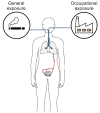Cadmium-induced Carcinogenesis in Respiratory Organs and the Prostate: Insights from Three Perspectives on Toxicogenomic Approach
- PMID: 38205367
- PMCID: PMC10774485
- DOI: 10.15430/JCP.2023.28.4.150
Cadmium-induced Carcinogenesis in Respiratory Organs and the Prostate: Insights from Three Perspectives on Toxicogenomic Approach
Abstract
Cadmium (Cd) exposure primarily occurs through inhalation, either by smoking or occupational exposure to contaminated air. Upon inhalation, Cd ultimately reaches the prostate through the bloodstream. In this review, we investigate the carcinogenic potential of Cd in both respiratory organs and the prostate. Specifically, this review examines cellular metabolism, comprehensive toxicity, and carcinogenic mechanisms by exploring gene ontology, biological networks, and adverse outcome pathways. In the respiratory organs, Cd induces lung cancer by altering the expression of IL1B and FGF2, causing DNA damage, reducing cell junction integrity, and promoting apoptosis. In the prostate, Cd induces prostate cancer by modifying the expression of EDN1 and HMOX1, leading to abnormal protein activities and maturation, suppressing tumor suppressors, and inducing apoptosis. Collectively, this review provides a comprehensive understanding of the carcinogenic mechanisms of Cd in two different organs by adopting toxicogenomic approaches. These insights can serve as a foundation for further research on cadmium-induced cancer, contributing to the establishment of future cancer prevention strategies.
Keywords: Adverse outcome pathways; Cadmium; Carcinogenesis; Computational biology; Toxicogenetics.
Copyright © 2023 Korean Society of Cancer Prevention.
Conflict of interest statement
CONFLICTS OF INTEREST No potential conflicts of interest were disclosed.
Figures



Similar articles
-
The dynamic face of cadmium-induced Carcinogenesis: Mechanisms, emerging trends, and future directions.Curr Res Toxicol. 2024 Apr 4;6:100166. doi: 10.1016/j.crtox.2024.100166. eCollection 2024. Curr Res Toxicol. 2024. PMID: 38706786 Free PMC article. Review.
-
Mechanisms of cadmium carcinogenesis.Toxicol Appl Pharmacol. 2009 Aug 1;238(3):272-9. doi: 10.1016/j.taap.2009.01.011. Epub 2009 Feb 6. Toxicol Appl Pharmacol. 2009. PMID: 19371617 Review.
-
Cadmium-induced differential toxicogenomic response in resistant and sensitive mouse strains undergoing neurulation.Toxicol Sci. 2009 Jan;107(1):206-19. doi: 10.1093/toxsci/kfn221. Epub 2008 Oct 29. Toxicol Sci. 2009. PMID: 18974090 Free PMC article.
-
Lasting DNA Damage and Aberrant DNA Repair Gene Expression Profile Are Associated with Post-Chronic Cadmium Exposure in Human Bronchial Epithelial Cells.Cells. 2019 Aug 6;8(8):842. doi: 10.3390/cells8080842. Cells. 2019. PMID: 31390735 Free PMC article.
-
Identification of molecular candidates and interaction networks via integrative toxicogenomic analysis in a human cell line following low-dose exposure to the carcinogenic metals cadmium and nickel.Oncol Rep. 2013 Sep;30(3):1185-94. doi: 10.3892/or.2013.2587. Epub 2013 Jul 4. Oncol Rep. 2013. PMID: 23828170
Cited by
-
Dysregulation of Long Non-coding RNAs-the Novel lnc in Metal Toxicity and Carcinogenesis.Curr Environ Health Rep. 2024 Dec 23;12(1):3. doi: 10.1007/s40572-024-00468-1. Curr Environ Health Rep. 2024. PMID: 39715843 Review.
-
The neuroprotective effect of N-acetylcysteine by regulating inflammation and expression of TNF-α and ERK gene expression in the rats exposed to different doses of cadmium.Mol Biol Rep. 2025 Jul 2;52(1):666. doi: 10.1007/s11033-025-10777-9. Mol Biol Rep. 2025. PMID: 40601178
-
Cadmium toxicity, health risk and its remediation using low-cost biochar adsorbents.Open Life Sci. 2025 Aug 11;20(1):20251131. doi: 10.1515/biol-2025-1131. eCollection 2025. Open Life Sci. 2025. PMID: 40822969 Free PMC article. Review.
References
Publication types
LinkOut - more resources
Full Text Sources
